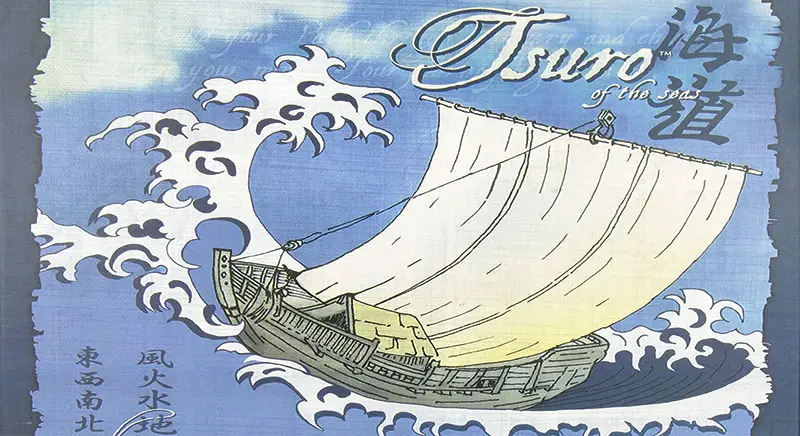
Tsuro of the Seas is a board game for two to eight players. Players sail their ships by placing wake tiles and moving their ships along the routes that begin at the edge of the board and travel through the mystic seas.
You will sail the treacherous waters of the Mystic Seas in an engaging game of adventure and suspense! As the captain of one of the Emperor's mighty Red Seal ships, you will navigate the seas by placing Tsuro wake tiles to direct your vessel.
Take great caution to avoid your opponents' ships … and those mysteries lurking on the horizon and under the sea.
Guide your ship with a steady hand and be the last captain sailing to survive the mystic seas and win! Set sail at once! You have a mighty quest to fulfill for the Emperor!
Components
- 1 game board
- 56 wake tiles
- 10 daikaiju tiles
- 8 Imperial Japanese Red Seal Ships
- 2 dice (1 gold, 1 bl ue)
The Wake Tiles
Each wake tile shows four lines, the ship's wake, that create eight points on the tile's edges. When the tiles are laid next to each other, these points line up and create a continuous ship wake. The wakes on a tile may cross one another, but movement proceeds uninterrupted along a single wake.
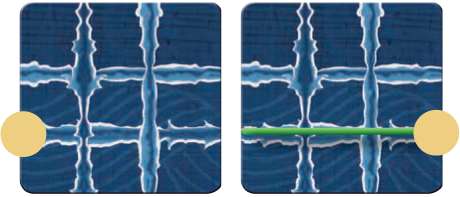
Starting Position and End Turn 1.
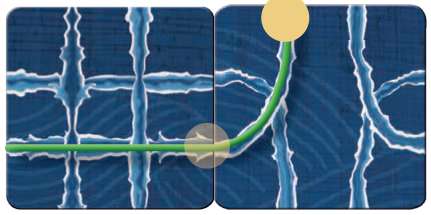
Turn 2: Player moves ship to end of wake trail.
Object of the Game
The object of the game is to prevent your ship from being destroyed by one of the daikaiju (giant monsters) AND avoid being forced out of the mystic seas to the edge of the game board. The last player remaining on the board is the winner!
Setup
- Lay out the game board.
- Each player chooses a ship to command.
- Shuffle the wake tiles and deal three tiles face down to each player. These tiles create your hand. You may look at the tiles in your hand at any time.
- Stack the remaining wake tiles face down. Th is stack is the draw pile.
- Place daikaiju (see below).
Placing the Daikaiju
Shuffle the daikaiju tiles an d pl ace them face down. The number of daikaiju placed on the board at the start of the game is based upon the number of players:
- For 2 to 4 players place 6 daikaiju
- For 5 to 6 players place 5 daikaiju
- For 7 to 8 players place 4 daikaiju
For each daikaiju to be placed, roll the gold and the blue die. Find the result of the gold die roll in the gold numbers along the top of the game board and then find the result of the blue die roll in the blue numbers along the left side of game board. Locate the square at the intersection of these two numbers an d pl ace a daikaiju tile face down in that square.
If the result of the die roll places two daikaiju in the same square, re-roll to place the second daikaiju in a different square. Rotate each daikaiju tile in a random direction and turn it face up.

Example: A gold die result of 2 and a blue die result of 5 places a daikaiju at the white square.
Game Play
The oldest player takes the first turn. Play continues to the left. The first player places his or her ship on any of the start marks (short white mar ks) on the outside edge of the game board. Continue clockwise around the board until each player has chosen a start mark and placed his or her ship on that mark.
All players should place their ships on start marks before any wake tiles are played. Each round has four parts. On each player's turn, he or she is called the active player, and performs the following actions:
Rolls the gold and blue dice; on a result of 6, 7, or 8, the player must move the daikaiju on the game board according to the Daikaiju Movement rules.
Places a wake tile.
Move his or her ship along the wake line.
Draw a wake tile.
Daikaiju Movement
The active player rolls to determine if a daikaiju his or her turn. Roll both the gold and the blue dice.
On a result of 6, 7, or 8 the daikaiju moves. Move or rotate the daikaiju in ascending order according to the rotation number in the corner of the tile (this is the number next to the curved arrow). If two daikaiju on the board have the same rotation number in the corner, move the daikaiju with the gold arrow first.
To determine how each daikaiju moves roll a single die. Compare the result to each daikaiju tile and move them according to the following guidelines:
On a result of 1-5, the daikaiju moves or rotates in the direction indicated by the directional arrows on each daikaiju tile.
On a result of 6, the daikaiju does not move. Instead a new daikaiju tile is placed according to the Placing the Daikaiju rules in Setup.
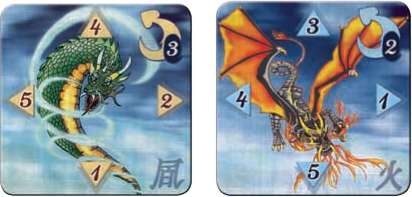
Daikaiju Tile Examples.
Daikaiju Rules
If a daikaiju's movement would force it off the game board, it is removed from play.
If a daikaiju moves to a square occupied by a wake tile, remove the wake tile from the game board, add it to the bottom of the draw pile, and move the daikaiju to that square. Any sh ip on the removed wake tile is also removed from the game board, and that player is out of the game.
If a daikaju moves to a square adjacent to the active player's ship, that ship is destroyed by the daikaiju and is eliminated from the game (the daikaiju prevents the player from placing a wake tile). If a second ship occupies the same side of the same wake tile (the ships are placed side by side facing the same direction), the second ship is not automatically destroyed by the daikaiju as the captain may avoid its wrath (the daikaiju may move before that player's turn)!
If a daikaiju moves to a square already occupied by a daikaiju tile, the moving daikaiju destroys the stationary daikaiju and the stationary daikaiju is removed from the game board.
There should always be a minimum of 3 daikaiju on the game board. If a daikaiju movement results in less than 3 daikaiju remaining on the board, then the next player must roll to place a number of daikaiju tile(s) (to a minimum o f 3) according to the Placing Daikaiju rules in Setup.
Once the daikaiju are placed, the player does not roll for daikaiju movement this turn. If the new daikaiju is placed in a space that is occupied by a wake tile, the wake tile is removed from the game. Any ships on that wake tile are destroyed and those players are out of the game.There is a slight chance that a daikaiju movement may prevent a player from taking their first move, either by occupying the first playable square or by exiting the board at the place where a ship still remains in their starting position. If this occurs, the player can move their ship to any other starting point on that same edge of the board as long as there is not a wake tile already there.
Place a Wake Tile
The active player chooses one of the wake tiles from his or her hand and places it on the open square next to his or her ship. The tile may be placed using any of the four sides. Once a tile has been placed, it cannot be moved for the rest of the game unless destroyed by a daikaiju, in which case the wake tile is removed from the game board. A player may not willingly:
Connect his or her own ship wake to the edge of the boar d (there by forcing himself out of the game) unless no other move is possible. Near the end of the game, it is possible to eliminate your ship in this manner.
Place his or her wake tile in such a way as to place his ship into an "endless loop" (thereby forcing himself out of the game) unless no other move is possible.
Connect his or her wake tile to a daikaiju tile (thereby forcing himself out of the game) unless no other move is possible.
Place his or her wake tile in such a way that it would cause two ships to travel the same ship wake in the same direction.
Move the Ship
The active player moves his or her ship forward to the open end of the ship's wake. If the new tile connects to the wake of any other player's ship, move that sh ip to the end of the ship's wake.
If the active player's wake tile placement connects two players' ship wakes, each ship moves to the open end of the new tile. The ships pass each other and do not collide. A player is eliminated from the game if the open end of his or her wake connects to the edge of the board or a daikaiju tile.
Elimination Bonus
If one or more opponents are eliminated as a result of a new wake tile being placed, the active player may immediately exchange any of the tiles in his or her hand for the same number of tiles from the eliminated players' hands.
The remaining tiles are added to the bottom of the draw pile. The active player still may draw a tile (see below).
Draw Tiles
After placing a wake tile and moving his ship to the end of the open wake, the active player draws a wake tile from the draw pile so that he has three tiles in his hand.
Any wake tiles removed from the game board by a daikaiju are returned to play by being added to the bottom of the draw pile.
End of the Game
When only one Imperial Red Seal ship remains on the board, that player wins the game.
If two or more players exit the board as a result of a wake tile being placed in the last available square, then both players win. They have successfully navigated and survived the dangers of these mystic seas!
Movement Examples

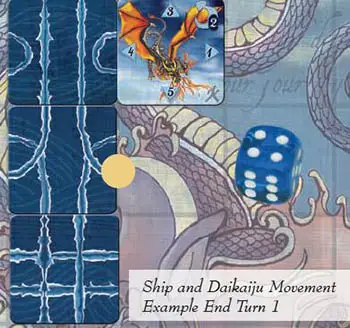
On Turn 1 of this example, the active player rolls a 4 f or the movement of the daikaiju. The daikaiju moves to the left based on the position of the 4 arrow. When the daikaiju moves to the left, it replaces the wake tile in that square and the tile is removed from the game board.
Now the active player places his wake tile and moves his ship. The position of his ship's wake and the movement of the daikaiju unfortunately places his ship close to the daikaiju at the start of turn 2.
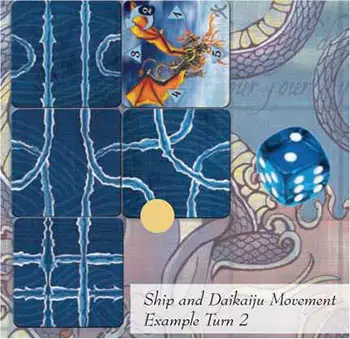
On Turn 2, the active player rolls a 2 for the movement of the daikaiju. This daikaiju simply rotates in place-which is very lucky for the active player. If the die roll result had been a 5, then the daikaiju would have moved into the square in front of his ship.
The daikaiju would have then eliminated him from the game by preventing him from placing a tile and destroying his ship. At the end of Turn 2 the lucky player places a ship wake tile that takes him away from the daikaiju and prays that the next player doesn't roll a 4!
Optional Rules
No Daikaiju: Players who prefer to play the game with no random elements can play without placing daikaiju. All other rules apply.
Continue Reading


